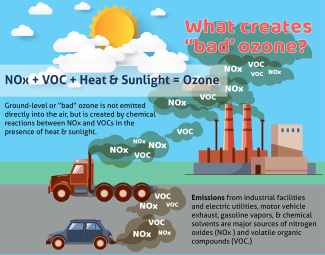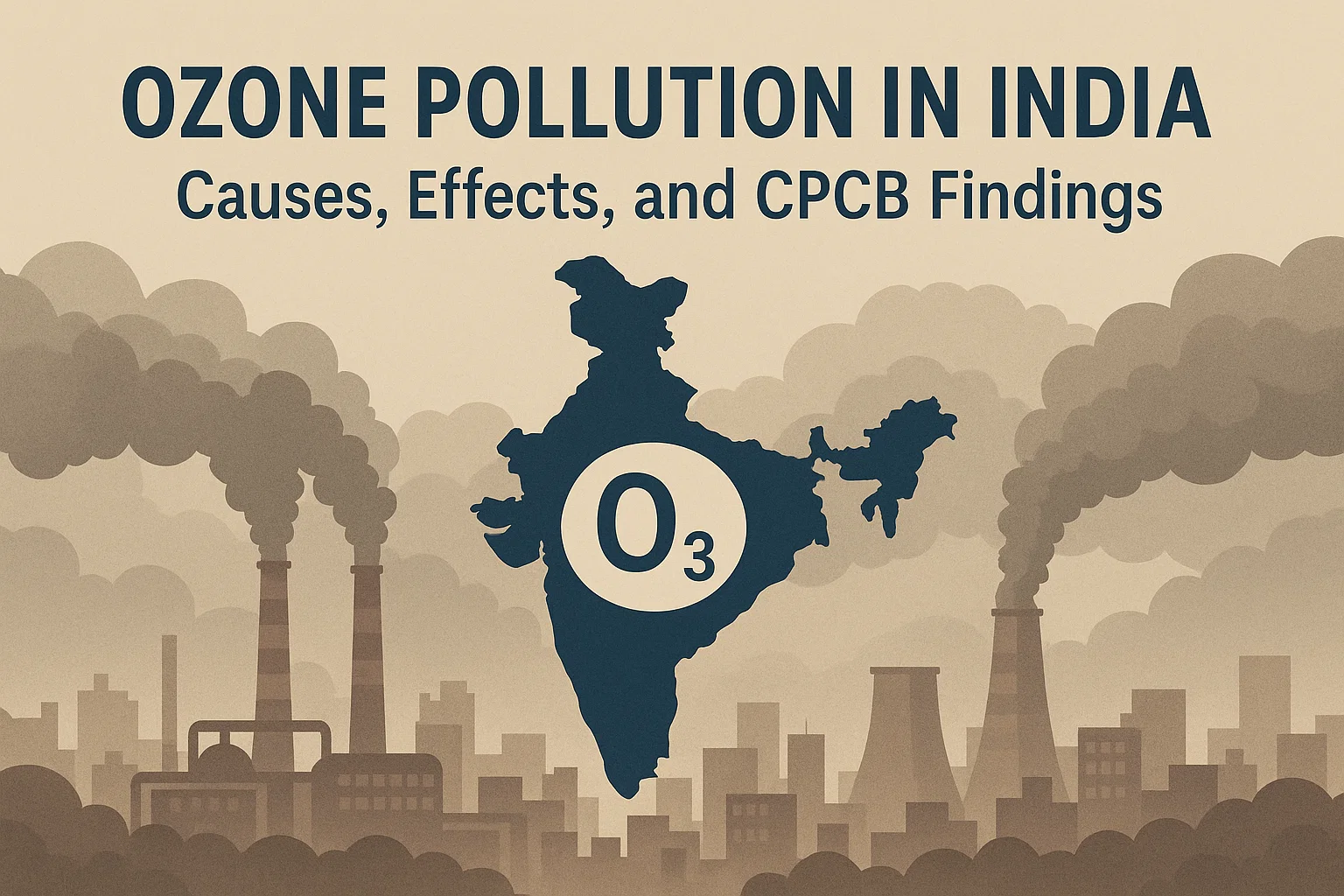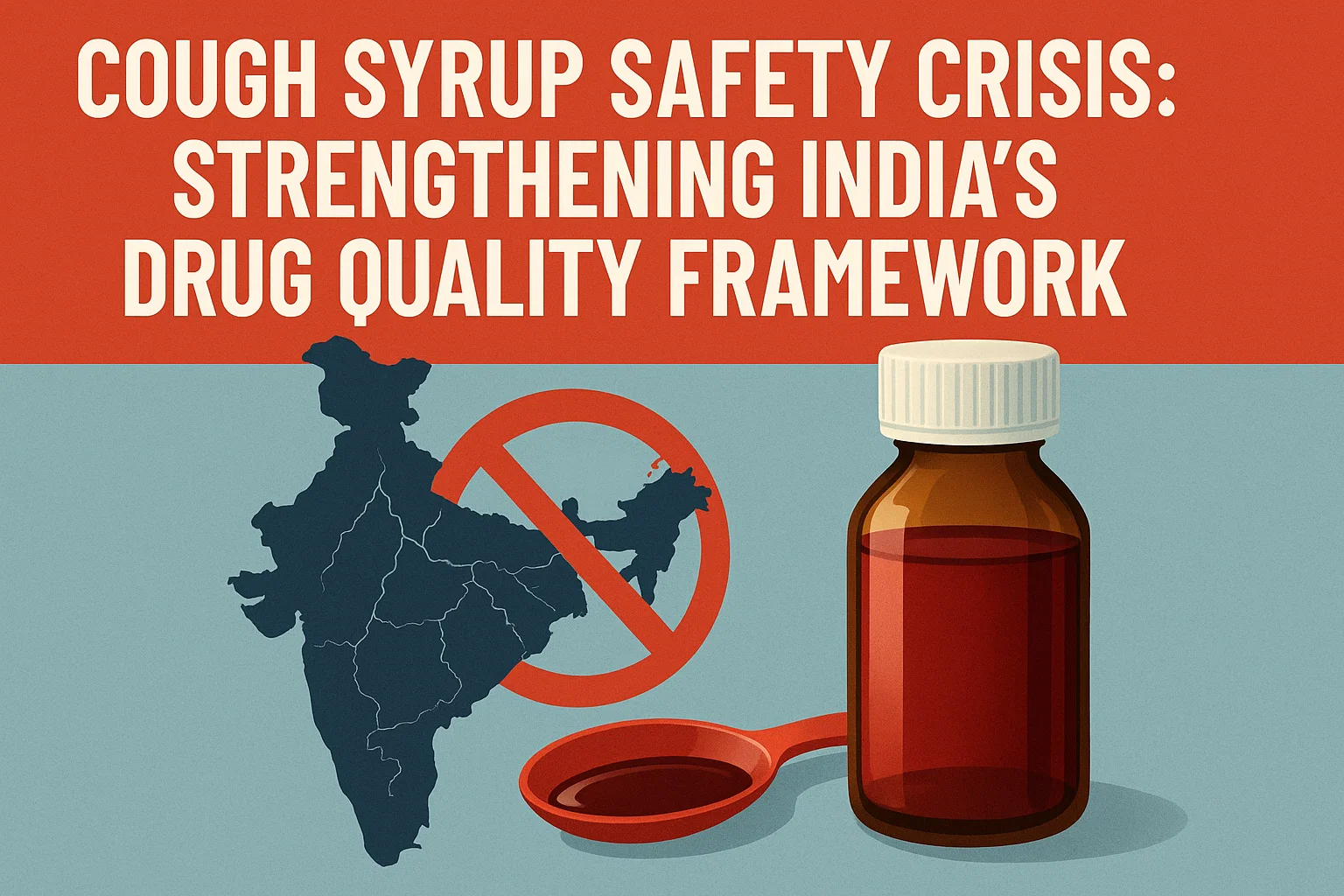Ozone Pollution in India – Causes, Effects, and CPCB Findings
India’s NCR faces the worst ozone pollution, says CPCB. Learn how ground-level ozone forms, its health and crop impacts, and the key policies tackling it under NCAP and BS-VI norms.
Context
The Central Pollution Control Board (CPCB) has informed the National Green Tribunal (NGT) that the National Capital Region (NCR) suffers the highest levels of ground-level ozone (O₃) pollution in India, followed closely by the Mumbai Metropolitan Region. This revelation highlights a growing public health and environmental challenge linked to urbanisation, vehicular growth, and industrial emissions.
What is Ozone Pollution?
Ground-level ozone is a harmful gas made up of three oxygen atoms (O₃). Unlike the protective ozone layer in the stratosphere, which shields Earth from ultraviolet radiation, ground-level ozone is toxic. It is a secondary pollutant, meaning it is not released directly into the atmosphere. Instead, it forms when nitrogen oxides (NOₓ) and volatile organic compounds (VOCs) react in the presence of sunlight — a process known as photochemical oxidation.
This pollutant is a key component of urban smog, particularly in hot and sunny conditions. It poses serious health risks to vulnerable groups such as children, the elderly, and individuals with respiratory ailments.

Impacts of Ozone Pollution
Human Health
Ozone exposure irritates the respiratory system, leading to coughing, throat irritation, chest discomfort, and congestion. It aggravates chronic diseases such as asthma and chronic obstructive pulmonary disease (COPD), while long-term exposure can lead to reduced lung function and heightened sensitivity to allergens. Hospitals in major Indian cities have reported seasonal spikes in respiratory illnesses that correlate with periods of high ozone concentration.
Agriculture and Vegetation
Ozone pollution also threatens food security. It damages leaves, hampers photosynthesis, and reduces the productivity of key crops including wheat, soybeans, and rice. Studies show that a sustained increase in ozone levels could cut crop yields by 10–20%, particularly in northern India’s fertile plains. This loss not only affects farmers’ livelihoods but also threatens national food supply stability.
Ecosystem and Climate
Ground-level ozone contributes to climate warming as a short-lived but potent greenhouse gas. It disrupts ecosystem balance, damages forest cover, and weakens the ability of vegetation to absorb carbon dioxide — thereby worsening the overall carbon footprint.
Strategies to Tackle Ozone Pollution
1. Vehicular Emission Control
The transport sector remains a dominant source of ozone precursors such as NOₓ and VOCs. India’s adoption of Bharat Stage VI (BS-VI) norms in 2020 has significantly reduced NOₓ emissions — by up to 87% compared with earlier standards.
To further curb pollution:
-
The PM-eDrive initiative promotes electric mobility, incentivising the adoption of e-vehicles to cut tailpipe emissions.
-
The government encourages alternative fuels such as CNG, LPG, and ethanol blends, which produce fewer VOCs and NOₓ.
2. Industrial and Power Sector Reforms
Industries and power plants are major emitters of ozone precursors.
-
Thermal power plants are adopting Low NOₓ Burners (LNBs), Over Fire Air (OFA) systems, and combustion optimisation technologies to reduce emissions.
-
Emission standards have been tightened for sectors such as pharmaceuticals, fertilisers, paints, cement, and boilers, targeting both VOC and NOₓ emissions.
3. Urban and Local Interventions
The National Clean Air Programme (NCAP), launched in 2019, now covers 130 non-attainment cities. It includes city-specific action plans to control road dust, domestic fuel burning, and industrial discharges.
In Delhi-NCR, Vapour Recovery Systems (VRS) have been installed at petrol stations to capture VOCs released during refuelling. These localised interventions have shown measurable reductions in pollution peaks during summer months.
4. Waste and Biomass Management
Open burning of biomass and waste — a major source of carbon monoxide (CO) and VOCs — has been banned under NGT directives. Improved landfill management and restoration of wetlands also help curb methane and other ozone-forming emissions. Public awareness drives are crucial in discouraging burning practices at household and community levels.
5. Monitoring and Data-Driven Action
Real-time air quality data are essential for tackling ozone. The CPCB’s online monitoring portal provides 15-minute interval readings across major cities, allowing early identification of pollution hotspots. Trend analysis is also needed to assess seasonal variations — such as the rise of ozone pollution in southern and coastal regions during high-temperature months.
Conclusion
Ozone pollution in India reflects the complex interaction of urban growth, industrial activity, and climate conditions. The NCR’s status as the most affected region underscores the need for coordinated action at local and national levels. Strengthening emission norms, expanding electric mobility, and improving monitoring mechanisms are vital to safeguarding public health and environmental stability.
India’s challenge is not just to control emissions but to build awareness, integrate policy, and sustain enforcement. Only through sustained effort can the country move towards cleaner air and a healthier, more resilient environment.
Subscribe to our Youtube Channel for more Valuable Content – TheStudyias
Download the App to Subscribe to our Courses – Thestudyias
The Source’s Authority and Ownership of the Article is Claimed By THE STUDY IAS BY MANIKANT SINGH





